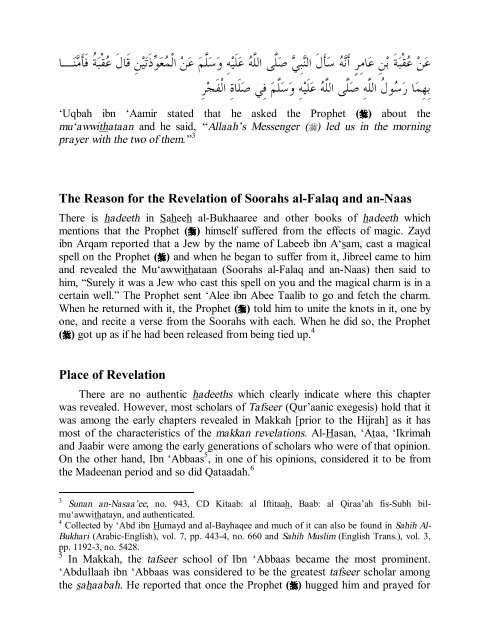You also want an ePaper? Increase the reach of your titles
YUMPU automatically turns print PDFs into web optimized ePapers that Google loves.
عن عق ْبة َ بنِ عامِرٍ أ َنه سأ َل َ النبِي صل َّى الل َّه عل َيهِ وسل َّم عن ال ْمعوذ َتينِ ق َال َ عق ْبة ُ ف َأ َمنا<br />
بِهِما رسول ُ الل َّهِ صل َّى الل َّه عل َيهِ وسل َّم فِي صل َاةِ ال ْف َجرِ<br />
‘ Uqbah ibn ‘Aamir stated that he asked the Prophet (r) about the<br />
mu‘awwithataan and he said, “Allaah’s Messenger (r) led us in the morning<br />
prayer with the two of them.” 3<br />
The Reason for the Revelation of Soorahs al-Falaq and an-Naas<br />
There is hadeeth in Saheeh al-Bukhaaree and other books of hadeeth which<br />
mentions that the Prophet (r) himself suffered from the effects of magic. Zayd<br />
ibn Arqam reported that a Jew <strong>by</strong> the name of Labeeb ibn A‘sam, cast a magical<br />
spell on the Prophet (r) and when he began to suffer from it, Jibreel came to him<br />
and revealed the Mu‘awwithataan (Soorahs al-Falaq and an-Naas) then said to<br />
him, “Surely it was a Jew who cast this spell on you and the magical charm is in a<br />
certain well.” The Prophet sent ‘Alee ibn Abee Taalib to go and fetch the charm.<br />
When he returned with it, the Prophet (r) told him to unite the knots in it, one <strong>by</strong><br />
one, and recite a verse from the Soorahs with each. When he did so, the Prophet<br />
(r) got up as if he had been released from being tied up. 4<br />
Place of Revelation<br />
There are no authentic hadeeths which clearly indicate where this chapter<br />
was revealed. However, most scholars of <strong>Tafseer</strong> (Qur’aanic exegesis) hold that it<br />
was among the early chapters revealed in Makkah [prior to the Hijrah] as it has<br />
most of the characteristics of the makkan revelations. Al-Hasan, ‘Ataa, ‘Ikrimah<br />
and Jaabir were among the early generations of scholars who were of that opinion.<br />
On the other hand, Ibn ‘Abbaas 5 , in one of his opinions, considered it to be from<br />
the Madeenan period and so did Qataadah. 6<br />
3<br />
Sunan an-Nasaa’ee, no. 943, CD Kitaab: al Iftitaah, Baab: al Qiraa’ah fis-Subh bilmu‘awwithatayn,<br />
and authenticated.<br />
4 Collected <strong>by</strong> ‘Abd ibn Humayd and al-Bayhaqee and much of it can also be found in Sahih Al-<br />
Bukhari (Arabic-English), vol. 7, pp. 443-4, no. 660 and Sahih Muslim (English Trans.), vol. 3,<br />
pp. 1192-3, no. 5428.<br />
5 In Makkah, the tafseer school of Ibn ‘Abbaas became the most prominent.<br />
‘Abdullaah ibn ‘Abbaas was considered to be the greatest tafseer scholar among<br />
the sahaabah. He reported that once the Prophet (r) hugged him and prayed for














